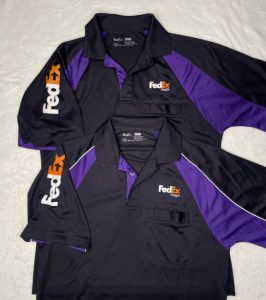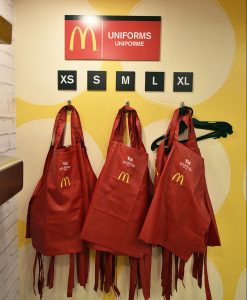
In today’s competitive business landscape, industrial garment branding has become an essential
element in establishing a strong and distinct identity. In the
world of branding strategies,
one instrument often overlooked is the humble customized uniform. While flashy logos and
catchy slogans steal the spotlight, the uniform quietly orchestrates a powerful
symphony of identity, consistency, and professionalism.
Visualize you strolling into a meeting, ready to pitch your next big idea.
On one side of the room, you’re greeted by an array of power suits and pencil
skirts, exuding confidence and professionalism. On the other, it’s a jungle of
flip-flops and graphic tees, signaling a more laid-back approach. Which team
would you put your money on?
In this expository exploration, we delve into the world of uncovering the
strategic significance of uniforms in shaping company branding.
Sure, we have all heard the saying – “don’t judge a book by its cover.” But
let’s face it, we are all guilty of sizing up a situation based on appearances.
And in the world of business, first impressions can make or break. That’s where
the magic of branding using uniforms comes into play.

At its core, a uniform is more than just a set of clothes; it’s a tangible
expression of a company’s ethos and values. Consider the iconic golden arches
of McDonald’s or the crisp green aprons of Starbucks baristas. These uniforms
transcend mere attire; they become symbols of reliability, quality, and
familiarity. By adorning employees in a consistent uniform, companies imbue
them with a sense of belonging and pride, transforming each individual into a
walking billboard for the brand.

But the power of uniforms extends far beyond brand visibility. They serve as
a visual cue for customers, signaling professionalism and competence. It is
all the difference it makes when you walk into a hospital and you’re greeted by
doctors clad in white coats adorned with hospital
logos and not in street clothes. It inspires confidence and trust, conveying
expertise and authority in a single glance.
But perhaps the most overlooked aspect of uniforms is their role in employee
morale and productivity.
Studies have shown that what we wear can actually affect how we think and
behave. Slip into a power suit, and suddenly you’re channeling your inner
superhero, ready to take on the world. Swap it for pajamas, and, well, the
productivity levels might just plummet.
Wearing a uniform can boost self-esteem and confidence, leading to improved
performance and customer interactions. When employees feel like they’re part of
something bigger than themselves, they’re more likely to go the extra mile to
uphold the company’s reputation and values.
To drive home the importance of branding through uniform colors, let’s
explore a few industries where this strategy has proven instrumental in their
distinctiveness and success:
SHOPRITE NIGERIA
As you stroll through the crowded aisles of a bustling Shoprite mall, carts

clattering, customers bustling. Amidst the organized chaos, one thing stands
out: the unmistakable sight of the vibrant burgundy uniforms of Shoprite
employees.
This striking visual identifier, helps customers easily spot the
knowledgeable sales associates ready to assist with their shopping needs. Store employees wearing branded
uniforms helps to establish the brand’s presence that further enhances customer
loyalty.
HILTON HOTELS & RESORTS

At Hilton Hotels and Resorts, uniforms are an integral part of their
corporate identity and branding strategy. It outfits its staff in stylish
shades of blue and white uniforms that reflect the brand’s commitment to luxury
and hospitality. This not only creates a cohesive and professional image but
has also set them apart from competitors.
From front desk associates to housekeeping staff, employees wear an iconic navy-blue
jackets, crisp white shirts, and pleated skirts for women or tailored pants for
men, paired with a discreet Hilton logo, an attire that exudes professionalism
and aligns with the upscale image of the Hilton brand.
FEDEX
FedEx is a prime example of a company that leverages branded uniforms to

enhance its brand identity and establish a strong customer association. FedEx riders are instantly recognizable
on the roads, thanks to their distinctive uniform, featuring a bold purple and
orange color scheme.
This consistent branding has set them apart from other courier services,
creating a unique visual identity that helps establish FedEx as a reliable and
professional choice for package delivery.
FedEx’s branded uniforms become a walking billboard, advertising the
company’s commitment to quality service and attention to detail.
MCDONALDS AND STARBUCKS

McDonalds and Starbucks are two renowned international brands known for
their standardized uniforms worn by employees worldwide.
McDonald’s uniforms typically feature the iconic golden arches logo and the
company’s signature colors, including the distinctive hats and aprons,
creating a consistent brand image across locations and reinforcing the
fast-food chains
.
Starbucks employees wear distinctive aprons and attire featuring the coffee

chain’s logo and colors, baristas wear the signature green aprons and black
shirts.
The uniforms contribute to Starbucks’ welcoming atmosphere and help customers
easily identify staff members, fostering a sense of familiarity and trust in
the brand.
NIGERIAN BREWERIES

Nigerian Breweries, the pioneer and largest brewing company in Nigeria, uses
uniforms for its employees in breweries, distribution centers, and promotional
events. The uniforms often incorporate branding elements from popular beer
brands like Star Lager and Gulder, contributing to brand recognition and consumer
loyalty. The company uses branded uniforms for its staff, including delivery
drivers and sales representatives. This creates a consistent and professional
image that customers recognize and trust.
Of course, implementing a uniform policy isn’t without its challenges.
Balancing practicality with aesthetics, ensuring inclusivity across diverse body
types and cultural backgrounds, and addressing employee feedback are just a few
considerations companies must navigate. However,
when done thoughtfully and inclusively, uniforms can be a powerful tool for
strengthening brand identity and fostering a sense of community within the
workplace.
The uniform, no doubt, may seem like a mundane aspect of corporate culture,
but its impact on branding and company culture should not be underestimated.
Companies around the world have harnessed the power of uniforms to communicate
their values, enhance customer experiences, and cultivate a sense of belonging
among employees. So, the next time you don your company polo or don your
branded apron, remember: you’re not just wearing clothes, you’re embodying the
essence of your company’s brand.
 In today’s competitive business landscape, industrial garment branding has become an essential
element in establishing a strong and distinct identity. In the world of branding strategies,
one instrument often overlooked is the humble customized uniform. While flashy logos and
catchy slogans steal the spotlight, the uniform quietly orchestrates a powerful
symphony of identity, consistency, and professionalism.
Visualize you strolling into a meeting, ready to pitch your next big idea.
On one side of the room, you’re greeted by an array of power suits and pencil
skirts, exuding confidence and professionalism. On the other, it’s a jungle of
flip-flops and graphic tees, signaling a more laid-back approach. Which team
would you put your money on?
In this expository exploration, we delve into the world of uncovering the
strategic significance of uniforms in shaping company branding.
Sure, we have all heard the saying – “don’t judge a book by its cover.” But
let’s face it, we are all guilty of sizing up a situation based on appearances.
And in the world of business, first impressions can make or break. That’s where
the magic of branding using uniforms comes into play.
In today’s competitive business landscape, industrial garment branding has become an essential
element in establishing a strong and distinct identity. In the world of branding strategies,
one instrument often overlooked is the humble customized uniform. While flashy logos and
catchy slogans steal the spotlight, the uniform quietly orchestrates a powerful
symphony of identity, consistency, and professionalism.
Visualize you strolling into a meeting, ready to pitch your next big idea.
On one side of the room, you’re greeted by an array of power suits and pencil
skirts, exuding confidence and professionalism. On the other, it’s a jungle of
flip-flops and graphic tees, signaling a more laid-back approach. Which team
would you put your money on?
In this expository exploration, we delve into the world of uncovering the
strategic significance of uniforms in shaping company branding.
Sure, we have all heard the saying – “don’t judge a book by its cover.” But
let’s face it, we are all guilty of sizing up a situation based on appearances.
And in the world of business, first impressions can make or break. That’s where
the magic of branding using uniforms comes into play.
 At its core, a uniform is more than just a set of clothes; it’s a tangible
expression of a company’s ethos and values. Consider the iconic golden arches
of McDonald’s or the crisp green aprons of Starbucks baristas. These uniforms
transcend mere attire; they become symbols of reliability, quality, and
familiarity. By adorning employees in a consistent uniform, companies imbue
them with a sense of belonging and pride, transforming each individual into a
walking billboard for the brand.
At its core, a uniform is more than just a set of clothes; it’s a tangible
expression of a company’s ethos and values. Consider the iconic golden arches
of McDonald’s or the crisp green aprons of Starbucks baristas. These uniforms
transcend mere attire; they become symbols of reliability, quality, and
familiarity. By adorning employees in a consistent uniform, companies imbue
them with a sense of belonging and pride, transforming each individual into a
walking billboard for the brand.
 But the power of uniforms extends far beyond brand visibility. They serve as
a visual cue for customers, signaling professionalism and competence. It is
all the difference it makes when you walk into a hospital and you’re greeted by
doctors clad in white coats adorned with hospital
logos and not in street clothes. It inspires confidence and trust, conveying
expertise and authority in a single glance.
But perhaps the most overlooked aspect of uniforms is their role in employee
morale and productivity.
Studies have shown that what we wear can actually affect how we think and
behave. Slip into a power suit, and suddenly you’re channeling your inner
superhero, ready to take on the world. Swap it for pajamas, and, well, the
productivity levels might just plummet.
Wearing a uniform can boost self-esteem and confidence, leading to improved
performance and customer interactions. When employees feel like they’re part of
something bigger than themselves, they’re more likely to go the extra mile to
uphold the company’s reputation and values.
To drive home the importance of branding through uniform colors, let’s
explore a few industries where this strategy has proven instrumental in their
distinctiveness and success:
SHOPRITE NIGERIA
As you stroll through the crowded aisles of a bustling Shoprite mall, carts
But the power of uniforms extends far beyond brand visibility. They serve as
a visual cue for customers, signaling professionalism and competence. It is
all the difference it makes when you walk into a hospital and you’re greeted by
doctors clad in white coats adorned with hospital
logos and not in street clothes. It inspires confidence and trust, conveying
expertise and authority in a single glance.
But perhaps the most overlooked aspect of uniforms is their role in employee
morale and productivity.
Studies have shown that what we wear can actually affect how we think and
behave. Slip into a power suit, and suddenly you’re channeling your inner
superhero, ready to take on the world. Swap it for pajamas, and, well, the
productivity levels might just plummet.
Wearing a uniform can boost self-esteem and confidence, leading to improved
performance and customer interactions. When employees feel like they’re part of
something bigger than themselves, they’re more likely to go the extra mile to
uphold the company’s reputation and values.
To drive home the importance of branding through uniform colors, let’s
explore a few industries where this strategy has proven instrumental in their
distinctiveness and success:
SHOPRITE NIGERIA
As you stroll through the crowded aisles of a bustling Shoprite mall, carts clattering, customers bustling. Amidst the organized chaos, one thing stands
out: the unmistakable sight of the vibrant burgundy uniforms of Shoprite
employees.
This striking visual identifier, helps customers easily spot the
knowledgeable sales associates ready to assist with their shopping needs. Store employees wearing branded
uniforms helps to establish the brand’s presence that further enhances customer
loyalty.
HILTON HOTELS & RESORTS
clattering, customers bustling. Amidst the organized chaos, one thing stands
out: the unmistakable sight of the vibrant burgundy uniforms of Shoprite
employees.
This striking visual identifier, helps customers easily spot the
knowledgeable sales associates ready to assist with their shopping needs. Store employees wearing branded
uniforms helps to establish the brand’s presence that further enhances customer
loyalty.
HILTON HOTELS & RESORTS
 At Hilton Hotels and Resorts, uniforms are an integral part of their
corporate identity and branding strategy. It outfits its staff in stylish
shades of blue and white uniforms that reflect the brand’s commitment to luxury
and hospitality. This not only creates a cohesive and professional image but
has also set them apart from competitors.
From front desk associates to housekeeping staff, employees wear an iconic navy-blue
jackets, crisp white shirts, and pleated skirts for women or tailored pants for
men, paired with a discreet Hilton logo, an attire that exudes professionalism
and aligns with the upscale image of the Hilton brand.
FEDEX
FedEx is a prime example of a company that leverages branded uniforms to
At Hilton Hotels and Resorts, uniforms are an integral part of their
corporate identity and branding strategy. It outfits its staff in stylish
shades of blue and white uniforms that reflect the brand’s commitment to luxury
and hospitality. This not only creates a cohesive and professional image but
has also set them apart from competitors.
From front desk associates to housekeeping staff, employees wear an iconic navy-blue
jackets, crisp white shirts, and pleated skirts for women or tailored pants for
men, paired with a discreet Hilton logo, an attire that exudes professionalism
and aligns with the upscale image of the Hilton brand.
FEDEX
FedEx is a prime example of a company that leverages branded uniforms to enhance its brand identity and establish a strong customer association. FedEx riders are instantly recognizable
on the roads, thanks to their distinctive uniform, featuring a bold purple and
orange color scheme.
This consistent branding has set them apart from other courier services,
creating a unique visual identity that helps establish FedEx as a reliable and
professional choice for package delivery.
FedEx’s branded uniforms become a walking billboard, advertising the
company’s commitment to quality service and attention to detail.
MCDONALDS AND STARBUCKS
enhance its brand identity and establish a strong customer association. FedEx riders are instantly recognizable
on the roads, thanks to their distinctive uniform, featuring a bold purple and
orange color scheme.
This consistent branding has set them apart from other courier services,
creating a unique visual identity that helps establish FedEx as a reliable and
professional choice for package delivery.
FedEx’s branded uniforms become a walking billboard, advertising the
company’s commitment to quality service and attention to detail.
MCDONALDS AND STARBUCKS
 McDonalds and Starbucks are two renowned international brands known for
their standardized uniforms worn by employees worldwide.
McDonald’s uniforms typically feature the iconic golden arches logo and the
company’s signature colors, including the distinctive hats and aprons,
creating a consistent brand image across locations and reinforcing the
fast-food chains.
Starbucks employees wear distinctive aprons and attire featuring the coffee
McDonalds and Starbucks are two renowned international brands known for
their standardized uniforms worn by employees worldwide.
McDonald’s uniforms typically feature the iconic golden arches logo and the
company’s signature colors, including the distinctive hats and aprons,
creating a consistent brand image across locations and reinforcing the
fast-food chains.
Starbucks employees wear distinctive aprons and attire featuring the coffee chain’s logo and colors, baristas wear the signature green aprons and black
shirts.
The uniforms contribute to Starbucks’ welcoming atmosphere and help customers
easily identify staff members, fostering a sense of familiarity and trust in
the brand.
NIGERIAN BREWERIES
chain’s logo and colors, baristas wear the signature green aprons and black
shirts.
The uniforms contribute to Starbucks’ welcoming atmosphere and help customers
easily identify staff members, fostering a sense of familiarity and trust in
the brand.
NIGERIAN BREWERIES
 Nigerian Breweries, the pioneer and largest brewing company in Nigeria, uses
uniforms for its employees in breweries, distribution centers, and promotional
events. The uniforms often incorporate branding elements from popular beer
brands like Star Lager and Gulder, contributing to brand recognition and consumer
loyalty. The company uses branded uniforms for its staff, including delivery
drivers and sales representatives. This creates a consistent and professional
image that customers recognize and trust.
Of course, implementing a uniform policy isn’t without its challenges.
Balancing practicality with aesthetics, ensuring inclusivity across diverse body
types and cultural backgrounds, and addressing employee feedback are just a few
considerations companies must navigate. However,
when done thoughtfully and inclusively, uniforms can be a powerful tool for
strengthening brand identity and fostering a sense of community within the
workplace.
The uniform, no doubt, may seem like a mundane aspect of corporate culture,
but its impact on branding and company culture should not be underestimated.
Companies around the world have harnessed the power of uniforms to communicate
their values, enhance customer experiences, and cultivate a sense of belonging
among employees. So, the next time you don your company polo or don your
branded apron, remember: you’re not just wearing clothes, you’re embodying the
essence of your company’s brand.
Nigerian Breweries, the pioneer and largest brewing company in Nigeria, uses
uniforms for its employees in breweries, distribution centers, and promotional
events. The uniforms often incorporate branding elements from popular beer
brands like Star Lager and Gulder, contributing to brand recognition and consumer
loyalty. The company uses branded uniforms for its staff, including delivery
drivers and sales representatives. This creates a consistent and professional
image that customers recognize and trust.
Of course, implementing a uniform policy isn’t without its challenges.
Balancing practicality with aesthetics, ensuring inclusivity across diverse body
types and cultural backgrounds, and addressing employee feedback are just a few
considerations companies must navigate. However,
when done thoughtfully and inclusively, uniforms can be a powerful tool for
strengthening brand identity and fostering a sense of community within the
workplace.
The uniform, no doubt, may seem like a mundane aspect of corporate culture,
but its impact on branding and company culture should not be underestimated.
Companies around the world have harnessed the power of uniforms to communicate
their values, enhance customer experiences, and cultivate a sense of belonging
among employees. So, the next time you don your company polo or don your
branded apron, remember: you’re not just wearing clothes, you’re embodying the
essence of your company’s brand.
